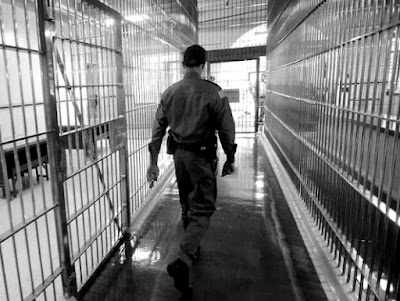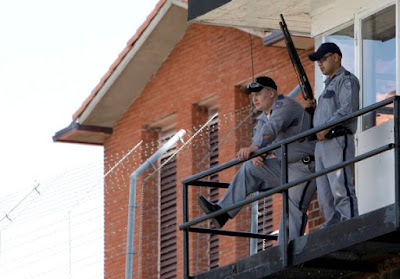Almost a third of Texas prison guards quit their jobs last year, as officer turnover rose yet again despite starting salary hikes and hiring bonuses.
Correctional officer turnover soared to over 29 percent, and agency-wide turnover checked in at 24.8 percent. Only two large state agencies — the Texas Health and Human Services Commission and Texas Juvenile Justice Department — saw more of their employees leave.
“We’ve never seen numbers like this,” said corrections officer Lance Lowry, a former union president. “It is a crisis.”
At the same time, the Texas Department of Criminal Justice is still battling high job vacancy rates, a problem officials have tackled in part by over-staffing a dozen units in desirable locations and then shipping extra officers to understaffed rural prisons for days at a time, according to state records.
And, while some units are enjoying an excess of guards, the number of facilities with an officer vacancy rate of more than 25 percent has nearly doubled in the past year.
The departures are driven by the same factors that have plagued the prison system for years: low salaries and remote locations, prison experts and officials said.
“We’re more than 3,000 corrections officers short,” said state Sen. John Whitmire, D-Houston, who chairs the Senate Criminal Justice Committee. “So what do you do? You raise the pay. But part of it is almost impossible — they put the prisons in all the wrong places.”
While the agency can’t move prisons to more populous locals, state officials can ask for more money — and they have, pitching across-the-board raises in the legislative funding request state lawmakers will start grappling with next week.
Strong economy means better jobs
The uptick in departures comes amid a rise in turnover across all state agencies, according to a year-end report from the Texas State Auditor’s Office.
Driven by a strong economy and low unemployment, overall turnover across state government rose to 19.3 percent in Texas, the highest figure seen in at least five years — as far back as the office’s online data goes.
In the prison system, guard turnover has been consistently higher than average, hovering around 25 percent from 2013 to 2015 and dipping to 22.8 in 2016.
Then in 2017, turnover rose to 28.2. At that point, Lowry called it a “mass exodus,” but this year the number went up again, to 29.5 percent.
All told, last year the prison system accounted for about 26 percent of the state workforce and 31 percent of departing employees.
Even as turnover figures rose, however, officials in recent months highlighted their success in bringing down vacancy figures. And that’s true — in some places.
In November 2017, correctional officer vacancy stood at 14.29 percent. Afterward, that number rose, peaking at 15.22 percent in April, the highest it has been in at least a decade, according to department data. The latest figures, from November 2018, show vacancies back down, to 14.17 percent.
Filling the gaps
But even as officer vacancy numbers have dipped slightly across the agency, the number of severely understaffed units increased while the most robustly staffed facilities gained more employees.
In November 2017, 12 units had less than 75 percent of the targeted staffing levels; in the latest figures from November 2018, that number rose to 22 units.
And, while there were no units more than 100 percent staffed at the end of 2017, the latest figures showed 12 units — almost all in metropolitan areas — were overstaffed.
Thus, while facilities like Segovia Unit in Edinburg and Hutchins State Jail in Dallas are more than 110 percent staffed, the Daniel Unit in rural Snyder, with a population 11,000, has a 45 percent officer vacancy.
Using those extra guards to bridge the gap, prison officials are now shipping workers from better-staffed units to those lacking officers.
“We are overstaffing at targeted units to have the ability to provide relief to correctional officers assigned to staff-challenged units,” said TDCJ Executive Director Bryan Collier. “This provides short-term help to stabilize staff levels so units can operate as normally and safely as possible.”

For one work cycle — four to five days — the agency will drive officers to understaffed units, putting them up in motels or in facility housing so they pick up unfilled shifts.
Lowry said the maneuvering does not make financial sense.
“They have an easier time recruiting in urban areas than rural areas,” he said. “A lot of times they have to travel to shorter units and work overtime. Then you end up having to pay them overtime for the travel.”
In the 2018 fiscal year, the department laid out more than $80 million in overtime pay for officers and sergeants. That was almost twice as much as the year before, and more than any other in the past decade, according to information obtained through a state open records request.
“At the present time,” Whitmire said, “they don’t have another option. You’ve got to have corrections officers to run a prison.”
‘A vicious cycle’
A strong economy and a robust oil and gas industry are two of the culprits behind the prison system’s entrenched staffing problems, experts and corrections officials say.
“When there is an economic climate as robust as it is in Texas correctional officer staffing has traditionally been a challenge,” said prison spokesman Jeremy Desel. “This year is no exception.”
But there’s also more to it than that, according to some experts.
“Turnover is not a systemwide problem, it’s unit-by-unit,” said Scott Henson, executive director with the criminal justice reform-focused nonprofit Just Liberty. “It’s that we’ve got a handful of units where it’s sort of chronic and as the economy booms, those are not great jobs.”
Often, data shows, those units are in rural locations and the ongoing staffing problems may simply beget more staffing problems.
“In the facilities where you’ve got understaffing, that leads to safety problems and then when it’s an unsafe environment the staff don’t want to be there and it creates a vicious cycle,” said Michele Deitch, an attorney and criminal justice consultant who teaches at the University of Texas at Austin’s LBJ School of Public Affairs.

Mark Adcock, a former captain at the Telford Unit in East Texas, concurred.
“You’re always working short handed,” he said. “If you have 40 peoples’ jobs and you only have 30 (people), you still have to do 40 people’s jobs. That, more than anything, drives people away.”
Short of decreasing the prison population or closing units in remote locations — both ideas advocates floated in the past — offering better pay may be one of the most immediate solutions to attract more workers.
To that end, the agency started with a starting salary increase for new officers effective February 2018. The state also shelled out more than $9 million last fiscal year in $4,000 and $5,000 recruitment bonuses.
But when that didn’t solve the problem, officials shot for a bigger ask with a $170 million legislative request to increase pay by a few thousand dollars at each step of the pay ladder.
The state Senate Finance Committee will start tackling the agency’s budget request on Monday.
Source: chron.com, Keri Blakinger, January 25, 2019
⚑ | Report an error, an omission, a typo; suggest a story or a new angle to an existing story; submit a piece, a comment; recommend a resource; contact the webmaster, contact us:
deathpenaltynews@gmail.com.
Opposed to Capital Punishment? Help us keep this blog up and running! DONATE!
"One is absolutely sickened, not by the crimes that the wicked have committed,
but by the punishments that the good have inflicted." -- Oscar Wilde















